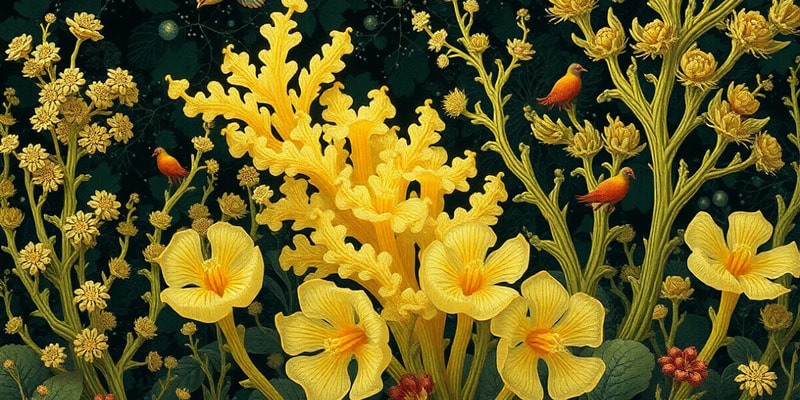Podcast
Questions and Answers
The cells in Eudorina are ______ and biflagellate.
The cells in Eudorina are ______ and biflagellate.
spherical
Oedogonium has a filamentous shape and the cells are ______.
Oedogonium has a filamentous shape and the cells are ______.
uninucleate
The characteristic of Charophyta is the formation of ______.
The characteristic of Charophyta is the formation of ______.
phragmoplast
In Oedogonium, the cells that can divide have stacks of old cell walls called ______.
In Oedogonium, the cells that can divide have stacks of old cell walls called ______.
Signup and view all the answers
The ______ of Volvox is composed of 8, 16, or sometimes 32 cells.
The ______ of Volvox is composed of 8, 16, or sometimes 32 cells.
Signup and view all the answers
Eudorina is composed of 16 or 32 cells loosely aggregated into a ______ shape.
Eudorina is composed of 16 or 32 cells loosely aggregated into a ______ shape.
Signup and view all the answers
Oedogonium is an unbranched ______ with only certain cells that can divide.
Oedogonium is an unbranched ______ with only certain cells that can divide.
Signup and view all the answers
In Charophyta, sexual reproduction involves ______ except in the stoneworts (Charales).
In Charophyta, sexual reproduction involves ______ except in the stoneworts (Charales).
Signup and view all the answers
The cells in Volvox are held together at their bases surrounded by ______.
The cells in Volvox are held together at their bases surrounded by ______.
Signup and view all the answers
Oedogonium exhibits ______ reproduction – oogamous; with flagellated zoospores meiosis.
Oedogonium exhibits ______ reproduction – oogamous; with flagellated zoospores meiosis.
Signup and view all the answers
Study Notes
Ulva and Volvox
- Belongs to Class Chlorophyceae, Order Volvocales.
- Vegetative stages may be flagellated or in coenobia formation.
- Gametes and zoospores are typically biflagellate; includes organisms like Volvox, Chlamydomonas, Pandorina, and Eudorina.
Oedogonium
- Class Oedogoniaceae; filamentous structure.
- Cells exhibit complex division featuring cell cap formation.
- Haploid with zygotic meiosis; reproduction is oogamous, producing flagellated zoospores and sperm with a ring of flagella.
Charophyta and Zygnematophyceae
- Part of Kingdom Viridiplantae, Subkingdom Streptobionta.
- Class Zygnematophyceae reproduces via conjugation with no flagellated stages.
- Organisms are haploid, reproducing through zygotic meiosis; primarily freshwater.
Orders in Charophyta
- Order Cosmariales (Desmidiales): Includes Micrasterias and Closterium.
- Order Zygnemataales: Comprises Zygnema and Spirogyra.
Class Charophyceae Characteristics
- Features macroscopic rhizoids and stems with branch whorls at nodes.
- Growth occurs from the apical cell; walls are heavily calcified.
- Sexual reproduction involves flagellated antherozoids produced in antheridia and oogonia within complex oogonia (nucule).
- Zygotes generate small protonema that develops into upright gametophytes.
Volvox Characteristics
- Composed of numerous flagellate cells, similar to Chlamydomonas, with a total of up to 50,000 cells.
- Cells are embedded in a gelatinous glycoprotein extracellular matrix forming a hollow sphere (coenobium).
Asexual Reproduction in Volvox
- Involves repeated mitotic division of zooids to form hollow spheres; flagellated ends face inward.
- Internal daughter colonies turn inside out from parent colony, forming similar structures before breaking free upon parent rupture.
Sexual Reproduction in Volvox
- Some zooids differentiate into macrogametes (larger, nutrient-rich) and microgametes (flagellated sperm).
- After fertilization, zygotes develop hard, protective shells, remaining dormant in winter.
- Zygotes undergo division, producing small organisms that emerge in spring.
Studying That Suits You
Use AI to generate personalized quizzes and flashcards to suit your learning preferences.
Description
Test your knowledge of the classification of green algae, including Chlorophyceae and Charophyta, and their characteristic features. Learn about the different orders, classes, and kingdoms, and how they are related.




